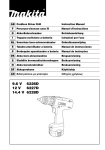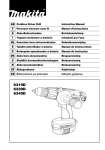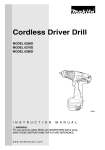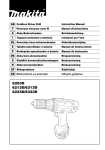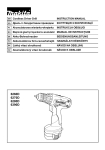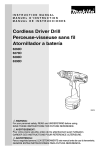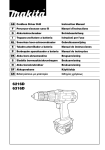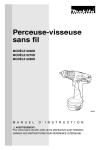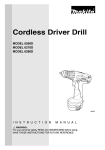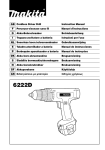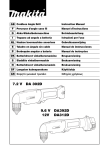Download Makita 6270D Instruction manual
Transcript
GB Cordless Driver Drill Instruction Manual F Perceuse-visseuse sans fil Manuel d’instructions D Akku-Bohrschrauber Betriebsanleitung I Trapano-avvitatore a batteria Istruzioni per l’uso NL Snoerloze boor-/schroevendraaier Gebruiksaanwijzing E Taladro-atornillador a batería Manual de instrucciones P Berbequim aparafusador a bateria Manual de instruções DK Akku bore-skruemaskine Brugsanvisning S Sladdlös borrmaskin/skruvdragare Bruksanvisning N Akku boreskrutrekker Bruksanvisning SF Akkuporakone Käyttöohje GR Βιδοτρύπανο µε µπαταρία Οδηγίες χρήσεως 6260D 6270D 6280D 6390D R 1 3 2 1 2 7 5 B A 4 6 3 4 12 9 8 14 10 11 13 5 7 2 6 ENGLISH Explanation of general view 1 2 3 4 5 Button Battery cartridge Switch trigger Reversing switch lever Low speed 6 7 8 9 10 High speed Speed change lever Graduations Adjusting ring Drill marking 11 12 13 14 Pointer Sleeve Ring Tighten SPECIFICATIONS Model 6260D Capacities Steel .............................................. 10 mm Wood ............................................. 21 mm Wood screw ................................... 5.1 mm x 38 mm Machine screw............................... 6 mm No load speed (min-1) High ...............................................0 – 1,200 Low ................................................ 0 – 350 Overall length ................................... 192 mm Net weight......................................... 1.4 kg Rated voltage ................................... D.C. 9.6 V 6270D 6280D 6390D 10 mm 25 mm 5.1 mm x 63 mm 6 mm 10 mm 25 mm 5.1 mm x 63 mm 6 mm 13 mm 36 mm 6 mm x 75 mm 6 mm 0 – 1,200 0 – 350 192 mm 1.5 kg D.C. 12 V 0 – 1,200 0 – 350 192 mm 1.6 kg D.C. 14.4 V 0 – 1,200 0 – 350 220 mm 2.2 kg D.C. 18 V • Due to our continuing program of research and development, the specifications herein are subject to change without notice. • Note: Specifications may differ from country to country. Intended use The tool is intended for drilling and screw driving in wood, metal and plastic. Safety hints For your own safety, please refer to the enclosed safety instructions. 7. 8. 9. SAVE THESE INSTRUCTIONS. Tips for maintaining maximum battery life 1. IMPORTANT SAFETY INSTRUCTIONS FOR CHARGER & BATTERY CARTRIDGE ENC004-1 1. 2. 3. 4. 5. 6. Before using battery cartridge, read all instructions and cautionary markings on (1) battery charger, (2) battery, and (3) product using battery. Do not disassemble battery cartridge. If operating time has become excessively shorter, stop operating immediately. It may result in a risk of overheating, possible burns and even an explosion. If electrolyte gets into your eyes, rinse them out with clear water and seek medical attention right away. It may result in loss of your eyesight. Always cover the battery terminals with the battery cover when the battery cartridge is not used. Do not short the battery cartridge: (1) Do not touch the terminals with any conductive material. (2) Avoid storing battery cartridge in a container with other metal objects such as nails, coins, etc. (3) Do not expose battery cartridge to water or rain. A battery short can cause a large current flow, overheating, possible burns and even a breakdown. Do not store the tool and battery cartridge in locations where the temperature may reach or exceed 50°C (122°F). Do not incinerate the battery cartridge even if it is severely damaged or is completely worn out. The battery cartridge can explode in a fire. Be careful not to drop or strike battery. 2. 3. 4. Charge the battery cartridge before completely discharged. Always stop tool operation and charge the battery cartridge when you notice less tool power. Never recharge a fully charged battery cartridge. Overcharging shortens the battery service life. Charge the battery cartridge with room temperature at 10°C – 40°C (50°F – 104°F). Let a hot battery cartridge cool down before charging it. Charge the Nickel Metal Hydride battery cartridge when you do not use it for more than six months. ADDITIONAL SAFETY RULES FOR POWER TOOL GEB002-2 DO NOT let comfort or familiarity with product (gained from repeated use) replace strict adherence to drill safety rules. If you use this power tool unsafely or incorrectly, you can suffer serious personal injury. 1. Hold power tools by insulated gripping surfaces when performing an operation where the cutting tool may contact hidden wiring or its own cord. Contact with a “live” wire will make exposed metal parts of the tool “live” and shock the operator. 2. Always be sure you have a firm footing. Be sure no one is below when using the tool in high locations. 3. Hold the tool firmly. 3 4. 5. 6. 7. Keep hands away from rotating parts. Do not leave the tool running. Operate the tool only when hand-held. Do not touch the drill bit or the workpiece immediately after operation; they may be extremely hot and could burn your skin. Some material contains chemicals which may be toxic. Take caution to prevent dust inhalation and skin contact. Follow material supplier safety data. SAVE THESE INSTRUCTIONS. WARNING: MISUSE or failure to follow the safety rules stated in this instruction manual may cause serious personal injury. FUNCTIONAL DESCRIPTION CAUTION: • Always be sure that the tool is switched off and the battery cartridge is removed before adjusting or checking function on the tool. Installing or removing battery cartridge (Fig. 1) • Always switch off the tool before insertion or removal of the battery cartridge. • To remove the battery cartridge, withdraw it from the tool while pressing the buttons on both sides of the cartridge. • To insert the battery cartridge, align the tongue on the battery cartridge with the groove in the housing and slip it into place. Always insert it all the way until it locks in place with a little click. If not, it may accidentally fall out of the tool, causing injury to you or someone around you. • Do not use force when inserting the battery cartridge. If the cartridge does not slide in easily, it is not being inserted correctly. Switch action (Fig. 2) CAUTION: • Before inserting the battery cartridge into the tool, always check to see that the switch trigger actuates properly and returns to the “OFF” position when released. To start the tool, simply pull the switch trigger. Tool speed is increased by increasing pressure on the switch trigger. Release the switch trigger to stop. Reversing switch action (Fig. 3) This tool has a reversing switch to change the direction of rotation. Depress the reversing switch lever from the A side for clockwise rotation or from the B side for counterclockwise rotation. When the reversing switch lever is in the neutral position, the switch trigger cannot be pulled. CAUTION: • Always check the direction of rotation before operation. • Use the reversing switch only after the tool comes to a complete stop. Changing the direction of rotation before the tool stops may damage the tool. • When not operating the tool, always set the reversing switch lever to the neutral position. 4 Speed change (Fig. 4) To change the speed, first switch off the tool and then slide the speed change lever to the “2” side for high speed or “1” side for low speed. Be sure that the speed change lever is set to the correct position before operation. Use the right speed for your job. CAUTION: • Always set the speed change lever fully to the correct position. If you operate the tool with the speed change lever positioned halfway between the “1” side and “2” side, the tool may be damaged. • Do not use the speed change lever while the tool is running. The tool may be damaged. Adjusting the fastening torque (Fig. 5) The fastening torque can be adjusted in 17 steps by turning the adjusting ring so that its graduations are aligned with the pointer on the tool body. The fastening torque is minimum when the number 1 is aligned with the pointer, and maximum when the m marking is aligned with the pointer. The clutch will slip at various torque levels when set at the number 1 to 16. The clutch is designed not to slip at the m marking. Before actual operation, drive a trial screw into your material or a piece of duplicate material to determine which torque level is required for a particular application. NOTE: • The adjusting ring does not lock when the pointer is positioned only halfway between the graduations. ASSEMBLY CAUTION: • Always be sure that the tool is switched off and the battery cartridge is removed before carrying out any work on the tool. Installing or removing driver bit or drill bit (Fig. 6) Hold the ring and turn the sleeve counterclockwise to open the chuck jaws. Place the bit in the chuck as far as it will go. Hold the ring firmly and turn the sleeve clockwise to tighten the chuck. To remove the bit, hold the ring and turn the sleeve counterclockwise. OPERATION Screwdriving operation (Fig. 7) CAUTION: • Adjust the adjusting ring to the proper torque level for your work. Place the point of the driver bit in the screw head and apply pressure to the tool. Start the tool slowly and then increase the speed gradually. Release the switch trigger as soon as the clutch cuts in. CAUTION: • Make sure that the driver bit is inserted straight in the screw head, or the screw and/or bit may be damaged. NOTE: • When driving wood screws, predrill pilot holes to make driving easier and to prevent splitting of the workpiece. See the chart. MAINTENANCE CAUTION: • Always be sure that the tool is switched off and the battery cartridge is removed before attempting to perform inspection or maintenance. To maintain product SAFETY and RELIABILITY, repairs, any other maintenance or adjustment should be performed by Makita Authorized or Factory Service Centres, always using Makita replacement parts. Nominal diameter of wood screw (mm) Recommended size of pilot hole (mm) 3.1 2.0 – 2.2 3.5 2.2 – 2.5 3.8 2.5 – 2.8 ACCESSORIES 4.5 2.9 – 3.2 4.8 3.1 – 3.4 5.1 3.3 – 3.6 5.5 3.7 – 3.9 CAUTION: • These accessories or attachments are recommended for use with your Makita tool specified in this manual. The use of any other accessories or attachments might present a risk of injury to persons. Only use accessory or attachment for its stated purpose. 5.8 4.0 – 4.2 6.1 4.2 – 4.4 Drilling operation First, turn the adjusting ring so that the pointer points to the m marking. Then proceed as follows. Drilling in wood When drilling in wood, the best results are obtained with wood drills equipped with a guide screw. The guide screw makes drilling easier by pulling the bit into the workpiece. If you need any assistance for more details regarding these accessories, ask your local Makita service center. • • • • • • • Drill bits Screw bits Rubber pad assembly Foam polishing pad Wool bonnet Various type of Makita genuine batteries and chargers Plastic carrying case Drilling in metal To prevent the bit from slipping when starting a hole, make an indentation with a center-punch and hammer at the point to be drilled. Place the point of the bit in the indentation and start drilling. Use a cutting lubricant when drilling metals. The exceptions are iron and brass which should be drilled dry. CAUTION: • Pressing excessively on the tool will not speed up the drilling. In fact, this excessive pressure will only serve to damage the tip of your bit, decrease the tool performance and shorten the service life of the tool. • There is a tremendous force exerted on the tool/bit at the time of hole break through. Hold the tool firmly and exert care when the bit begins to break through the workpiece. • A stuck bit can be removed simply by setting the reversing switch to reverse rotation in order to back out. However, the tool may back out abruptly if you do not hold it firmly. • Always secure small workpieces in a vise or similar hold-down device. • If the tool is operated continuously until the battery cartridge has discharged, allow the tool to rest for 15 minutes before proceeding with a fresh battery. 5 NEDERLANDS Verklaring van algemene gegevens 1 2 3 4 5 Knop Accu Trekschakelaar Omkeerschakelaar Laag toerental 6 7 8 9 10 Hoog toerental Toerentalschakelaar Schaalverdelingen Stelring Boormarkering TECHNISCHE GEGEVENS Model 6260D Capaciteiten Staal ............................................. 10 mm Hout .............................................. 21 mm Houtschroef .................................. 5,1 mm x 38 mm Kolomschroef ................................ 6 mm Toerental onbelast (min-1) Hoog ............................................. 0 – 1 200 Laag ............................................. 0 – 350 Totale lengte .................................... 192 mm Netto gewicht ................................... 1,4 kg Nominale spanning ......................... D.C. 9,6 V 6280D 6390D 10 mm 25 mm 5,1 mm x 63 mm 6 mm 10 mm 25 mm 5,1 mm x 63 mm 6 mm 13 mm 36 mm 6 mm x 75 mm 6 mm 0 – 1 200 0 – 350 192 mm 1,5 kg D.C. 12 V 0 – 1 200 0 – 350 192 mm 1,6 kg D.C. 14,4 V 0 – 1 200 0 – 350 220 mm 2,2 kg D.C. 18 V Doeleinden van gebruik Dit gereedschap is bedoeld voor het boren en het indraaien van schroeven in hout, metaal en plastic. Veiligheidswenken Voor uw veiligheid dient u de bijgevoegde Veiligheidsvoorschriften nauwkeurig op te volgen. BELANGRIJKE VEILIGHEIDSVOORSCHRIFTEN VOOR ACCULADER EN ACCU 2. 3. 4. 5. 6. 16 Wijzer Bus Ring Vastdraaien 6270D • In verband met ononderbroken research en ontwikkeling behouden wij ons het recht voor bovenstaande technische gegevens te wijzigen zonder voorafgaande kennisgeving. • Opmerking: De technische gegevens kunnen van land tot land verschillen. 1. 11 12 13 14 Lees alle voorschriften en waarschuwingen op (1) de acculader, (2) de accu, en (3) het product waarvoor de accu wordt gebruikt, aandachtig door alvorens de acculader in gebruik te nemen. Neem de accu niet uit elkaar. Als de gebruikstijd van een opgeladen accu aanzienlijk korter is geworden, moet u het gebruik ervan onmiddellijk stopzetten. Voortgezet gebruik kan oververhitting, brandwonden en zelfs een ontploffing veroorzaken. Als er elektrolyt in uw ogen is terechtgekomen, spoel dan uw ogen met schoon water en roep onmiddellijk de hulp van een dokter in. Elektrolyt in de ogen kan blindheid veroorzaken. Bedek de accuklemmen altijd met de accukap wanneer u de accu niet gebruikt. Voorkom kortsluiting van de accu: (1) Raak de accuklemmen nooit aan met een geleidend materiaal. (2) Bewaar de accu niet in een bak waarin andere metalen voorwerpen zoals spijkers, munten e.d. worden bewaard. (3) Stel de accu niet bloot aan water of regen. 7. 8. 9. Kortsluiting van de accu kan oorzaak zijn van een grote stroomafgifte, oververhitting, brandwonden, en zelfs defecten. Bewaar het gereedschap en de accu niet op plaatsen waar de temperatuur kan oplopen tot 50°C of hoger. Werp de accu nooit in het vuur, ook niet wanneer hij zwaar beschadigd of volledig versleten is. De accu kan namelijk ontploffen in het vuur. Wees voorzichtig dat u de accu niet laat vallen en hem niet blootstelt aan schokken of stoten. BEWAAR DEZE VOORSCHRIFTEN. Tips voor een maximale levensduur van de accu 1. 2. 3. 4. Laad de accu op voordat hij volledig ontladen is. Stop het gebruik van het gereedschap en laad de accu op telkens wanneer u vaststelt dat het vermogen van het gereedschap is afgenomen. Laad een volledig opgeladen accu nooit opnieuw op. Als u de accu te veel oplaadt, zal hij minder lang meegaan. Laad de accu op bij een kamertemperatuur tussen 10°C en 40°C. Laat een warme accu afkoelen alvorens hem op te laden. Laad de nikkel-metaalhydride accu op telkens wanneer u hem langer dan zes maanden niet hebt gebruikt. AANVULLENDE VEILIGHEIDSVOORSCHRIFTEN VOOR HET ELEKTRISCH GEREEDSCHAP Volg de veiligheidsvoorschriften voor boren ALTIJD strict op en laat u NIET misleiden door gemak of vertrouwdheid met het product (verworven na langdurig gebruik). Als u dit elektrisch gereedschap op een onveilige of onjuiste manier gebruikt, bestaat er gevaar voor ernstige persoonlijke verwonding. 1. 2. 3. 4. 5. 6. 7. Houd elektrisch gereedschap vast bij de geïsoleerde handgreepoppervlakken wanneer u een werk uitvoert waarbij het snijgereedschap met verborgen bedrading of met zijn eigen netsnoer in aanraking kan komen. Door contact met onder spanning staande draden zullen de metalen delen van het gereedschap onder spanning komen te staan zodat de gebruiker een elektrische schok kan krijgen. Zorg ervoor dat u altijd stevige steun voor de voeten hebt. Controleer of er zich niemand beneden u bevindt wanneer u het gereedschap op een hoge plaats gaat gebruiken. Houd het gereedschap stevig vast. Houd uw handen uit de buurt van de draaiende onderdelen. Laat het gereedschap niet achter terwijl het nog in bedrijf is. Bedien het gereedschap alleen wanneer u het met beide handen vasthoudt. Raak de boor of het werkstuk niet aan onmiddellijk na het gebruik; deze kunnen erg heet zijn en brandwonden veroorzaken. Sommige materialen bevatten chemische stoffen die giftig kunnen zijn. Neem de nodige voorzorgsmaatregelen tegen inademing van stof en contact met de huid. Volg de veiligheidsinstructies van de leverancier van het materiaal op. BEWAAR DEZE VOORSCHRIFTEN. WAARSCHUWING: VERKEERD GEBRUIK of het niet naleven van de veiligheidsvoorschriften in deze gebruiksaanwijzing kan leiden tot ernstige verwondingen. BESCHRIJVING VAN DE FUNCTIES LET OP: • Zorg altijd dat het gereedschap is uitgeschakeld en de accu ervan is verwijderd alvorens de functies op het gereedschap af te stellen of te controleren. Installeren of verwijderen van de accu (Fig. 1) • Schakel het gereedschap altijd uit alvorens de accu te installeren of te verwijderen. • Om de accu te verwijderen, neemt u deze uit het gereedschap terwijl u de knoppen aan beide zijden van de accu indrukt. • Om de accu te installeren, past u de rug op de accu in de groef in de behuizing van het gereedschap, en dan schuift u de accu naar binnen. Schuif de accu zo ver mogelijk erin, totdat deze met een klikgeluid vergrendelt. Indien u dit niet doet, kan de accu per ongeluk uit het gereedschap vallen en uzelf of anderen verwonden. • Als de accu moeilijk in de houder gaat, moet u niet proberen hem met geweld erin te duwen. Indien de accu er niet gemakkelijk ingaat, betekent dit dat u hem niet op de juiste wijze erin steekt. Werking van de trekschakelaar (Fig. 2) LET OP: • Alvorens de accu in het gereedschap te plaatsen, moet u altijd controleren of de trekschakelaar juist werkt en bij het loslaten naar de “OFF” positie terugkeert. Om het gereedschap in te schakelen, drukt u gewoon de trekschakelaar in. Hoe dieper de trekschakelaar wordt ingedrukt, hoe sneller het gereedschap draait. Om het gereedschap uit te schakelen, de trekschakelaar loslaten. Werking van de omkeerschakelaar (Fig. 3) Dit gereedschap heeft een omkeerschakelaar voor het veranderen van de draairichting. Druk de omkeerschakelaar in vanaf zijde A voor rechtse draairichting, of vanaf zijde B voor linkse draairichting. Wanneer deze schakelaar in de neutrale stand staat, kan de trekschakelaar niet worden ingedrukt. LET OP: • Controleer altijd de draairichting alvorens het gereedschap te gebruiken. • Verander de stand van de omkeerschakelaar alleen nadat het gereedschap volledig tot stilstand is gekomen. Indien u de draairichting verandert terwijl de boor nog draait, kan het gereedschap beschadigd raken. • Zet de omkeerschakelaar altijd in de neutrale stand wanneer u het gereedschap niet gebruikt. Veranderen van het toerental (Fig. 4) Om het toerental te veranderen, schakelt u eerst het gereedschap uit en dan schuift u de toerentalschakelaar naar de “2” zijde voor hoog toerental, of naar de “1” zijde voor laag toerental. Zorg ervoor dat de toerentalschakelaar in de juiste stand staat alvorens met het werk te beginnen. Gebruik het toerental dat geschikt is voor uw werk. LET OP: • Schuif de toerentalschakelaar altijd volledig naar de juiste positie. Als u het gereedschap gebruikt met de toerentalschakelaar halverwege tussen de “1” en “2” posities, kan het gereedschap beschadigd raken. • Verschuif de toerentalschakelaar niet terwijl het gereedschap draait. Hierdoor kan het gereedschap beschadigd raken. Instellen van het draaimoment (Fig. 5) Het draaimoment kan worden ingesteld in 17 stappen door de stelring zodanig te draaien dat zijn schaalverdelingen overeenkomen met de wijzer op het huis van het gereedschap. Het draaimoment is minimaal wanneer het cijfer 1 met de wijzer overeenkomt, en is maximaal wanneer de markering met de wijzer overeenkomt. Wanneer de stelring op een cijfer van 1 tot 16 is ingesteld, zal de koppeling bij verschillende draaimomentniveaus slippen. De koppeling is ontworpen om niet te slippen bij de m markering. Alvorens met het eigenlijke werk te beginnen, moet u het geschikte draaimoment bepalen door een proefschroef in uw werkstuk of in een ander stuk van hetzelfde materiaal te schroeven. OPMERKING: • De stelring vergrendelt niet wanneer de wijzer halverwege tussen de schaalverdelingen is geplaatst. 17 INEENZETTEN LET OP: • Controleer altijd of het gereedschap is uitgeschakeld en de accu is losgekoppeld vooraleer onderhoud uit te voeren aan het gereedschap. Installeren of verwijderen van de schroefbit of boor (Fig. 6) Houd de ring vast en draai de bus naar links om de klauwen van de boorkop te openen. Steek de boor zo ver mogelijk in de boorkop. Houd daarna de ring weer stevig vast en draai de bus naar rechts om de boorkop vast te zetten. Om de boor te verwijderen, houdt u de ring vast en draait u de bus naar links. BEDIENING Indraaien van schroeven (Fig. 7) LET OP: • Stel de stelring in op het draaimomentniveau dat geschikt is voor uw werk. Plaats de punt van de schroefbit in de schroefkop en oefen druk op het gereedschap uit. Begin met lage snelheid en voer dan de snelheid geleidelijk op. Laat de trekschakelaar los zodra de koppeling ingrijpt. LET OP: • Zorg ervoor dat u de schroefbit recht op de schroefkop plaatst, aangezien anders de schroef en/of de schroefbit beschadigd kan worden. OPMERKING: • Wanneer u houtschroeven indraait, maak dan voorboorgaten in het hout. Dit vergemakkelijkt het inschroeven en voorkomt dat het hout splijt. Zie de onderstaande tabel. Nominale diameter van houtschroef (mm) Aanbevolen diameter van voorboorgat (mm) 3,1 2,0 – 2,2 3,5 2,2 – 2,5 3,8 2,5 – 2,8 4,5 2,9 – 3,2 4,8 3,1 – 3,4 5,1 3,3 – 3,6 5,5 3,7 – 3,9 5,8 4,0 – 4,2 6,1 4,2 – 4,4 ONDERHOUD LET OP: • Controleer altijd of het gereedschap is uitgeschakeld en de accu is losgekoppeld voordat u begint met inspectie of onderhoud. Om de VEILIGHEID en BETROUWBAARHEID van het gereedschap te verzekeren, dienen alle reparaties, onderhoudsbeurten of afstellingen te worden uitgevoerd bij een erkend Makita Servicecentrum of Fabriekservicecentrum, en dit uitsluitend met gebruik van Makita vervangingsonderdelen. Raadpleeg het dichtstbijzijnde Makita Servicecentrum voor verder advies of bijzonderheden omtrent deze accessoires. naar Boren in hout Voor boren in hout krijgt u de beste resultaten met houtboren die voorzien zijn van een geleideschroef. Het boren gaat dan gemakkelijker aangezien de geleideschroef de boor in het hout trekt. 18 LET OP: • Door overmatige druk op het gereedschap uit te oefenen verloopt het boren niet sneller. Integendeel, teveel druk op het gereedschap zal alleen maar de boorpunt beschadigen, de prestatie van het gereedschap verminderen en de gebruiksduur verkorten. • Wanneer de boor uit het gaatje tevoorschijn komt, wordt een enorme kracht uitgeoefend op het gereedschap en op de boor. Houd daarom het gereedschap stevig vast en wees op uw hoede wanneer de boor door het werkstuk begint te dringen. • Wanneer de boor klemraakt, keert u met de omkeerschakelaar de draairichting om, om de boor uit het gaatje te krijgen. Het gereedschap kan echter plotseling terugspringen indien u het niet stevig vasthoudt. • Kleine werkstukken dient u altijd eerst vast te zetten in een klemschroef of iets dergelijks. • Indien het gereedschap ononderbroken wordt gebruikt totdat de accu is ontladen, dient u het gereedschap 15 minuten te laten rusten alvorens met een nieuwe accu verder te werken. ACCESSOIRES LET OP: • Deze accessoires of hulpstukken worden aanbevolen voor gebruik met het Makita gereedschap dat in deze gebruiksaanwijzing is beschreven. Bij gebruik van andere accessoires of hulpstukken bestaat er gevaar voor persoonlijke verwonding. Gebruik de accessoires of hulpstukken uitsluitend voor hun bestemde doel. Boren Draai eerst de stelring zodat de wijzer de m markering wijst. Ga daarna als volgt te werk. Boren in metaal Om te voorkomen dat de boor slipt wanneer u begint te boren, moet u van te voren met een drevel een deukje in het metaal slaan op de plaats waar u wilt boren. Plaats vervolgens de boorpunt in het deukje en start het boren. Gebruik altijd boorolie wanneer u in metaal boort. De enige uitzonderingen zijn ijzer en koper die droog geboord dienen te worden. • • • • • • • Boren Schroefbits Rubber steunschijf set Schuimrubber polijstkussen Wollen poetsschijf Diverse types originele Makita accu’s en acculaders Plastic draagkoffer
This document in other languages
- Nederlands: Makita 6270D








